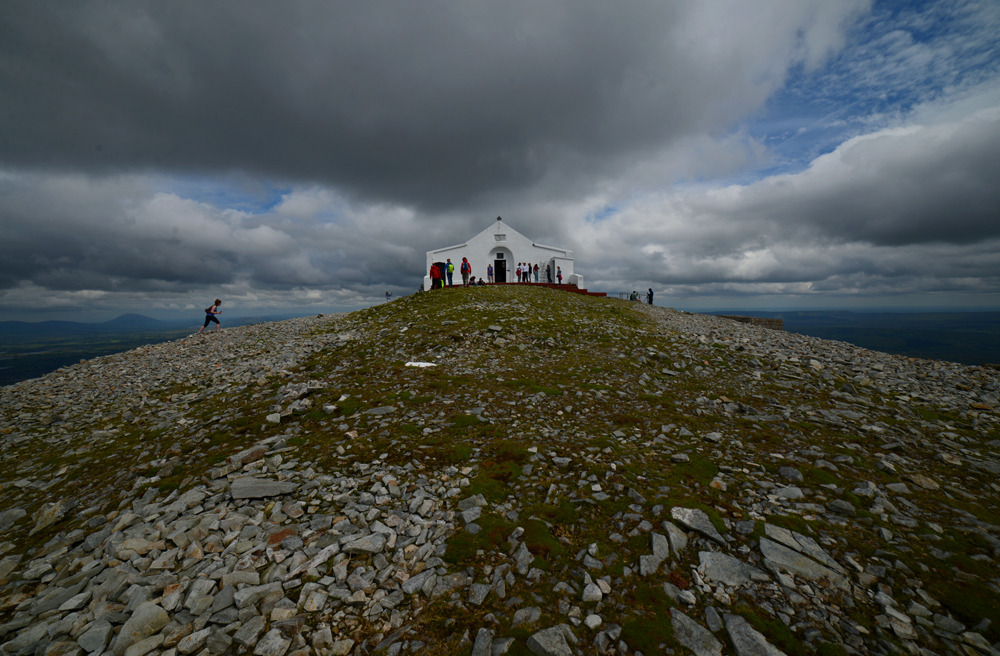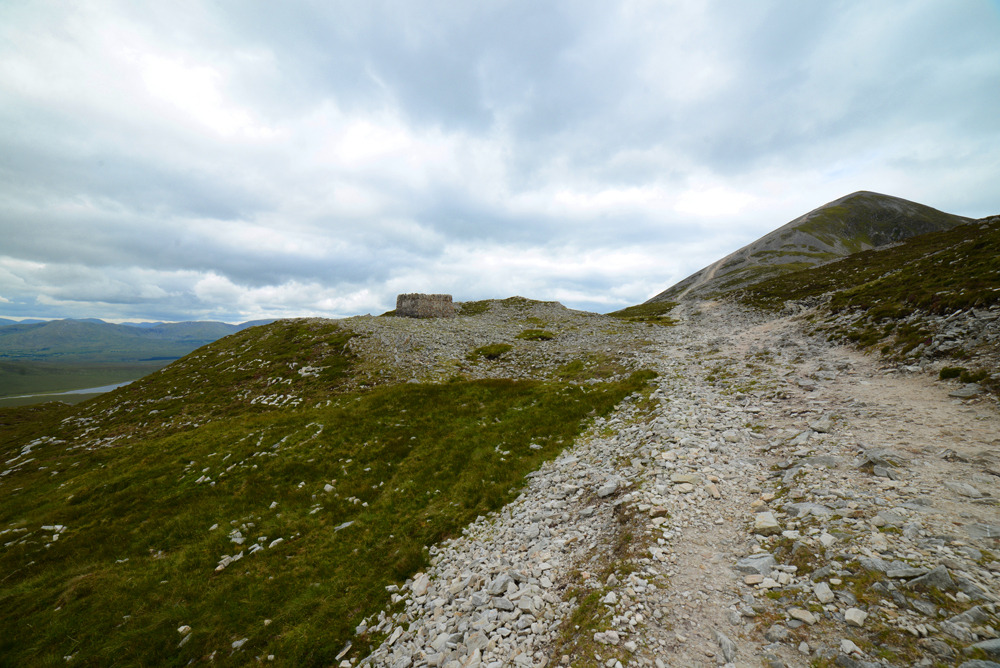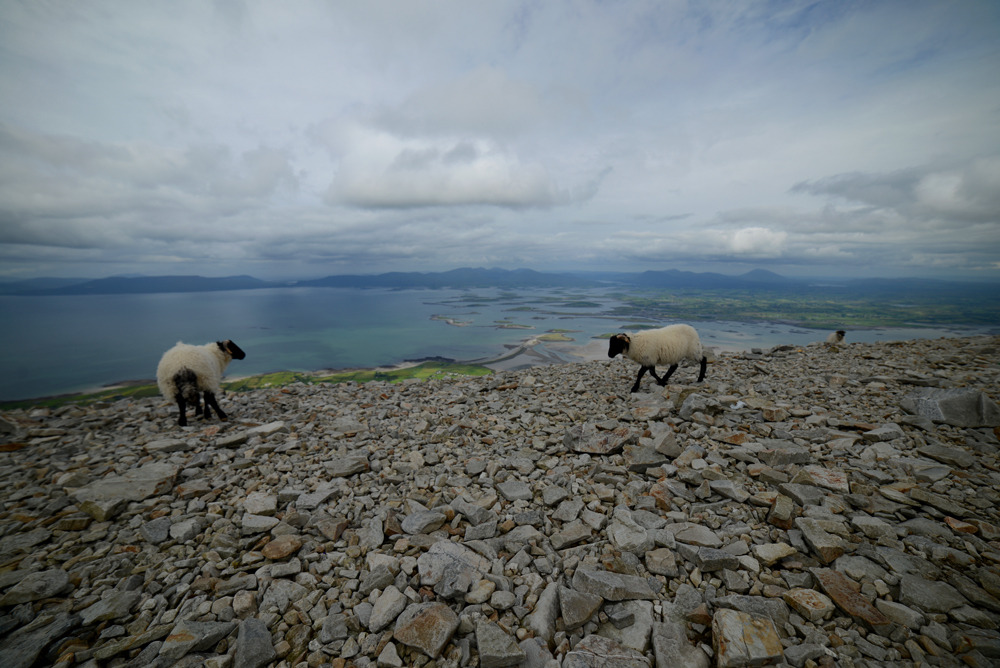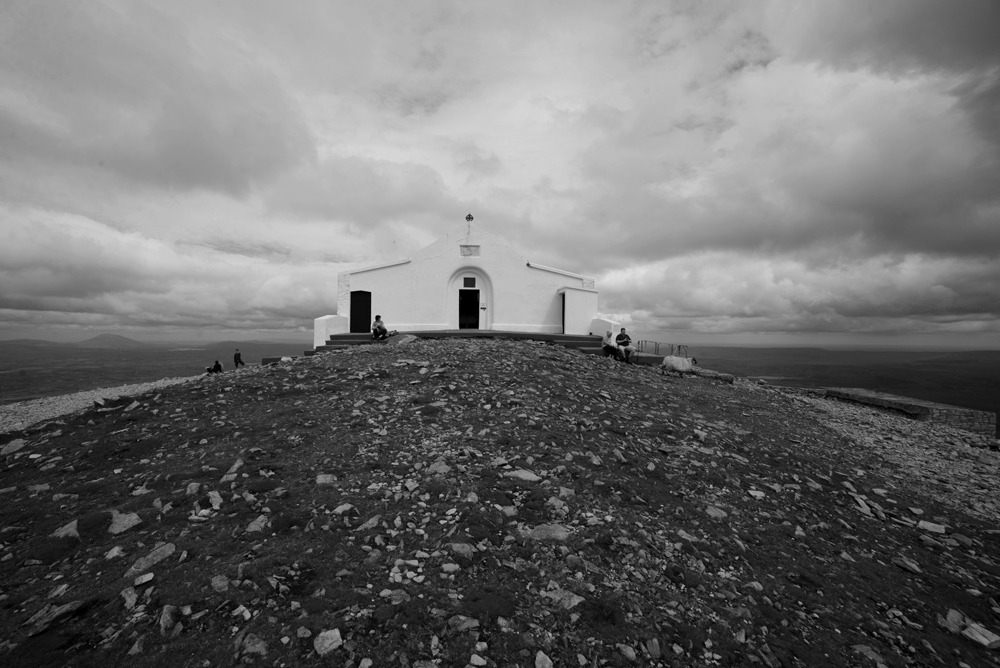I believe that was the phrase that drew me in. First, because of the sheer exuberance of the mental picture it painted. I imagined a tight procession of tiny octogenarian ladies – faces weather-beaten, backs bent under the weight of rucksacks, tanned limbs chalky with mountain dust under long skirts, callused feet leaving a trail of blood up a narrow path that winds, winds its way up the mountain to the tiny chapel in the clouds.
The mention of the old women also serves to make the climb seem accessible. If the frail devout dears do this bare-footed, it cannot possibly be that difficult. What is a pilgrimage anyway? If the Cantenbury Tales are anything to go by, basically a long walk.

We set out on a day that started off hot. 20 degrees may not seem like a lot to those from warmer parts of the world, but there is something about the climate in Ireland, with its special flavor of dense mid-summer humidity, that makes 20 feel closer to 40, and the term “heat wave” does not feel misapplied when used unironically by locals.
The mountain sits right on the coast, and making our way to it from the nearby town of Westport we marveled at the luxurious bike paths spreading in all directions with fantastical island and mountain views. Today Croagh Patrick, but tomorrow certainly bikes.

The start of the climb was immediately tight and steep. So steep, that after climbing for just a few minutes one could turn around to see sweeping views of Clew Bay and its scattered islands.
The climb was also immediately rocky. At first the rocks weren’t loose, but firmly embedded into the soil. Jutting out from the steep pitch at strange angles, they made for extremely awkward footholds, making the climb like an intense, vertical game of Twister. An additional layer of excitement was added by these rocks’ sleekness. Perhaps that had to do with the stream nearby, or maybe whatever kind of rock this was just inherently slippery. But even in my good hiking boots, stepping on some of these rocks was not unlike stepping on ice - the larger and more stable a rock looked, the more likely this being the case.

For someone moderately fit like myself, the difficulty of the climb was a little embarrassing to acknowledge, especially considering how many other people - (pilgrims!) - were attempting it alongside me without complaint. There were no devout old women in bare feet as had been promised. But there were elderly persons of both genders, as well as children and variously aged adults, dressed in a dazzling variety of footwear and clothing from technical climbing gear to sundresses and sandals. Most moved very slowly, taking plenty of breaks, but with an air of determination about reaching the top. The heat and humidity of the day had risen a few degrees by now, and my clothes - a thin wool top and lightweight leggings - were already drenched in sweat. I had drunk a third of the 1L bottle of water I'd brought with me, and eaten a handful of trail mix.
As the climb progressed, it continued to grow steeper, until it reached a plateau. Here the final stretch to the peak loomed in the distance like a mountain in its own right.
At this stage there was only a third of the way left (the climb being 3 miles in each direction), and this fostered a sense of being "almost there." However, the last stretch to the peak was the most difficult. Here again the trail as such disappeared, with climbers struggling to pick the least treacherous line up the now near-vertical rockface. The surface here consisted not of loose rocks in the standard sense of that word, but of loose thin flat slabs of what must have been quartz. These slabs combined the sleek properties of the large sturdy stones in the first part of the climb, with the unstable, crumply properties of the loose gravel in the second part of the climb. This, in addition to the steeper-than-ever pitch, made the final section stunningly difficult and time consuming. As I climbed, gaining height proportionally to distance, not only did the flat jagged slabs of stone give out under my feet, but my boots also slipped on the rock surface itself. Now and again I would lose my footing and fall forward onto my knees, bracing with my hands so as not to slide backwards and down. It was then it occurred to me how difficult it would be to get down this slope on the return trip, with my sense of balance. But for the time being, I suppressed this thought, aiming for the top.

To one side stretched the mountains of inland Mayo and the neighbouring County Galway. To the other, acres of peat fields spread across the mossy hillside, dotted by sprinklings of young heather.
But the most prized view was that of Clew Bay, showing the mad messy scattering of tiny islands it is famous for, of which there are said to be 365. Here, several sheep - their coats and improbably clean shade of white - patrolled the viewing point, charging pilgrims admission for approach - the currency being banana peals and sandwich crusts.
Since not long after St. Patrick’s time, there has stood on this mountain a chapel of some sort or another. The current one is a white, tidy little structure that is kept functional by a caretaker who climbs to it 4 times a week (albeit along a less steep alternative route to the Pilgrimage trail). On special occasions, Mass is held here, with thousands of people attending - which also means climbing to reach it.
Considering how many people had been climbing the mountain alongside me, there were not a great many at the top - perhaps a dozen, which makes me think that many turn back at some point. Here I also finally saw a barefooted woman. Looking to be at least in her mid-70s, she was sinewy and tanned, dressed in high-tech hiking gear and a bandanna around her forehead, her bare feet sturdy on the slippery rocks. Just as I reached the top, she began to descend, singing songs radiantly.
Alas, my own descent was neither celebratory nor composed. To put it bluntly, I could not get down the steep top part of the mountain. I tried it this way and that, but I only slid and tumbled, losing my footing with nearly every step down the vertical rockface.
Above me and below, the pilgrims who had made it this far and now needed to get down did so the best way they could. Their methods varied wildly, from running with jaw-dropping confidence, to a weepy slip-sliding down on their behinds. The latter was a method I had seriously considered. The tops of my thighs began to burn with the effort of bracing myself against gravity's pull and the rocky downslide. My legs trembled and gave out form underneath me, weakened by effort and anxiety.
At one point, I found myself unable to pick a line through the dangerous slippery rock and, exhausted, I collapsed on my behind and began to sob involuntarily. A woman on her way up seized the opportunity to remind me triumphantly that Jesus was with me. "Be brave my girl, and Christ will save you!" I stopped myself just in time before replying with the first thing that popped into my head. "Does he have a helicopter?"

At the pub hung vintage photos of Mass held at Croagh Patrick Chapel at the turn of the 20th century. Men in suits and brimmed hats. Women in long skirts and high heeled boots with elaborate Edwardian hair. Feeling my own still-drenched top, I imagined doing the climb in a long tweed skirt and heels, then pedaling home on a high-geared fixed wheel roadster. People must have been hardier in the day, as well as more religious, to subject themselves to such an adventure. A pilgrim I am not. But there's nothing like ruining your legs for days that makes you pine for cycling, singing a song of thanksgiving once you're fit to pedal again.





Tidak ada komentar:
Posting Komentar